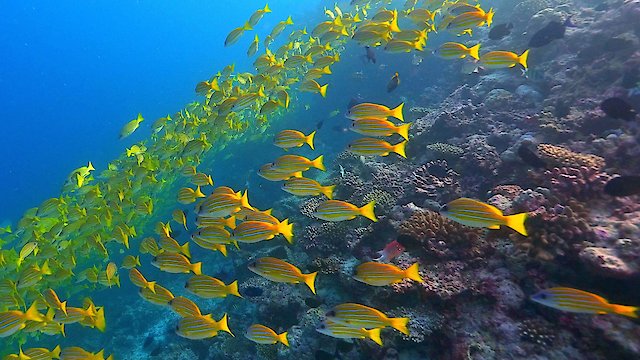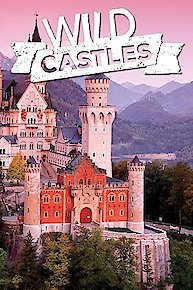
Great Blue Wild
Where to Watch Great Blue Wild
Watch Great Blue Wild Season 3 Episode 4 Now
Watch Great Blue Wild Season 3 Episode 3 Now
Watch Great Blue Wild Season 3 Episode 2 Now
Watch Great Blue Wild Season 3 Episode 1 Now

Great Blue Wild is a captivating and insightful nature documentary series that was produced and aired by Smithsonian Earth from 2015-2016. Offering a stunning, underwater exploration of the world's most beautiful yet mysterious ecosystems, the series brings an immersive experience into the comfort of your living room. Taking an exploratory plunge below the ocean's surface, Great Blue Wild grants audiences a unique opportunity to observe oceanic wildlife in its natural habitat, studying their behavior and their crucial role in the marine ecosystem.
The breathtaking series comprises six episodes, each running for approximately 50 minutes to deliver an in-depth and engrossing gaze into the diverse oceanic environment. The series is filmed in high-definition against the mesmerizing backdrop of the world's most pristine and stunning aquatic landscapes. From the extraordinary reefs of Indonesia to the frigid seas of Alaska, each episode is designed to take viewers on a truly enchanting journey into the came-less-travelled regions of our planet.
Great Blue Wild goes beyond the typical run-of-the-mill wildlife narration by focusing more on the conservation and ecology of the areas it explores. Through a mix of state-of-the-art cinematography equipment and underwater technology, the series demonstrates an unrivaled visual experience with crisp detail and vibrant colors that only enhances the portrayal of life beneath the waves.
Nature enthusiasts and marine conservationists will especially appreciate the series as it delves into the daily lives and activities of a myriad of marine creatures, from small, yet intricate coral polyps to the gargantuan sperm whales. The series doesn’t shy away from focusing on the micro level either, allowing viewers to marvel at the complexity of planktonic life, which forms the base of the marine food chain.
The star of each episode alternatively switches between a specific marine animal and a particular ocean. For instance, some episodes solely focus on the marine predators such as the mighty sharks, whilst others primarily concentrate on the endearing manatees, also dubbed sea cows. The filming teams get remarkably close to these marine animals, capturing the action as it unfolds, whether it be a sea turtle carefully laying her eggs in the sand or a school of dolphins playfully frolicking in the waves.
However, Great Blue Wild is not merely about the sparkling surface of the sea; it plunges into the mysterious, deep oceans as well. Offering intimate encounters with squids, jellyfish, and other bizarre deep-sea creatures, it paints a captivating portrait of life in the largely uncharted abysmal depths of the oceans.
The series is narrated by a highly skilled and engaging narrator who offers a rich and detailed commentary throughout the episodes. From detailing the habits and habitats of the underwater denizens to discussing the environmental impact of human actions on these ecosystems, the series doesn’t shy away from shedding light on the hard-hitting facts. At the same time, the narrator remarkably manages to strike a balance between scientific information and engaging storytelling, thereby guaranteeing a gripping viewing experience that captivates a variety of audiences.
Great Blue Wild is also seriously committed to showcasing the relentless yet remarkable conservation efforts carried out by scientists and environmental activists worldwide. By highlighting the vital significance of marine conservation, and pointing out the direct and indirect effects of human activities on the marine ecosystem, the series effectively delivers an urgent and subtle call-to-action.
In a nutshell, Great Blue Wild is a mesmerizing uncovering of the strange marvels that dwell beneath the ocean's surface. It is a powerful and enchanting collection of narratives that delve into mysteries of the deep sea and the fascinating life forms it harbors. This series is educational, evocative, and a must-watch for both wildlife enthusiasts and the curious-minded. It's a visual treat that brings perspective, engagement, and real-world relevance to your screen, filling viewers with a sense of awe and reverence for our splendid blue planet.
Great Blue Wild is a series categorized as a returning series. Spanning 3 seasons with a total of 18 episodes, the show debuted on 2015. The series has earned a moderate reviews from both critics and viewers. The IMDb score stands at 7.4.
How to Watch Great Blue Wild
How can I watch Great Blue Wild online? Great Blue Wild is available on Smithsonian Earth with seasons and full episodes. You can also watch Great Blue Wild on demand at Amazon Prime, Paramount+ online.






























